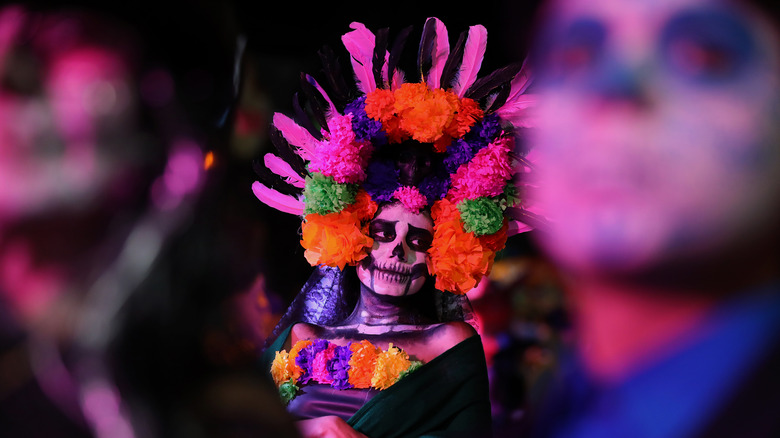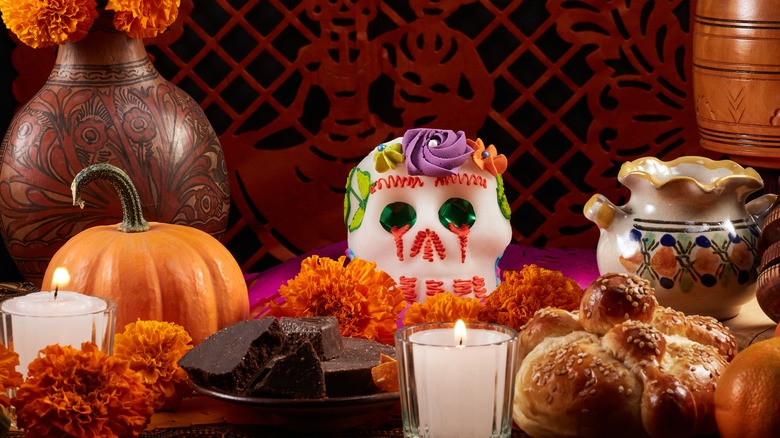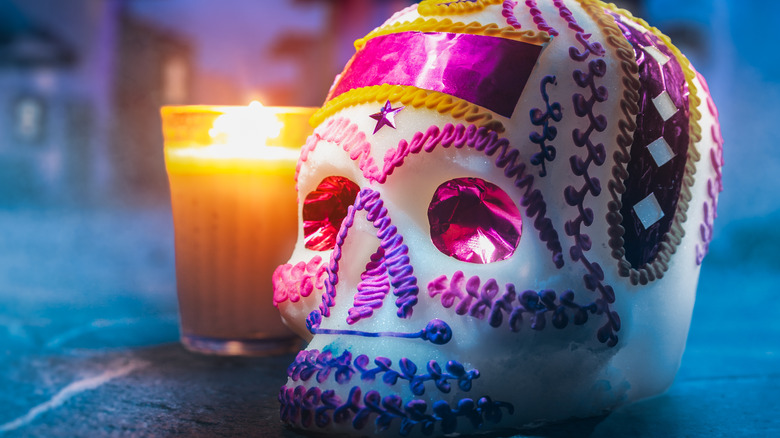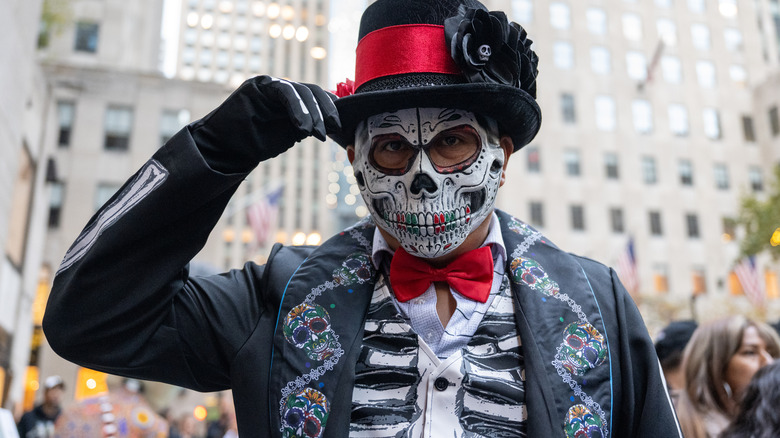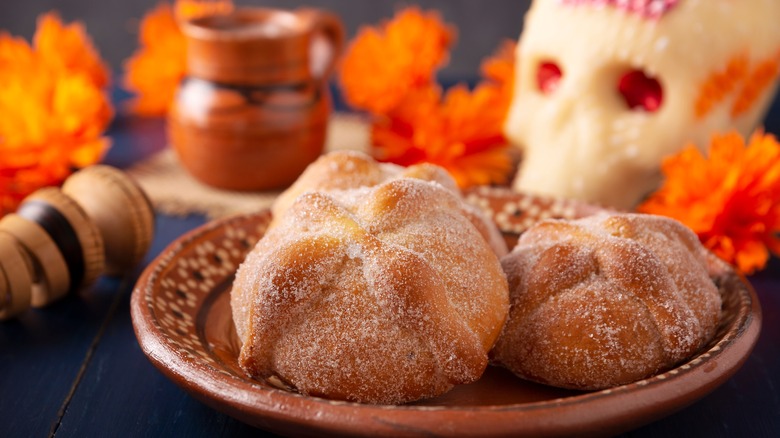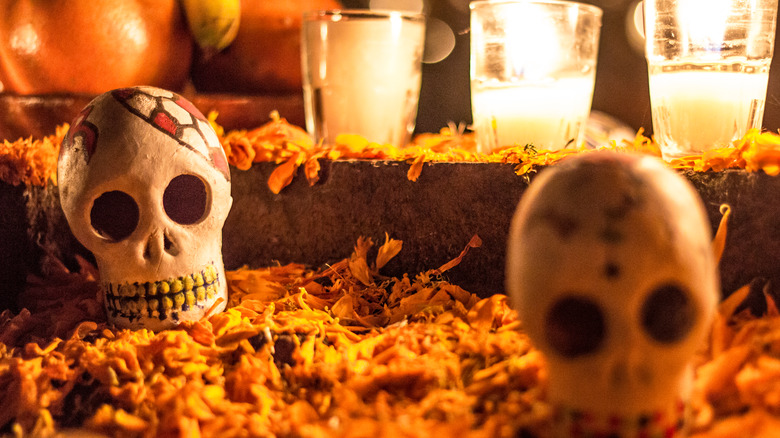How Day Of The Dead Is Really A Celebration Of Life
Skeletons may be a creepy part of Halloween, but they take on a wholly different significance on the Day of the Dead (or Dia de los Muertos), which follows right on the heels of Halloween. Traditionally, the Day of the Dead is celebrated on November 1 and 2. The holiday features skeletons, altars, candy in the shape of skulls, and marigolds. While the observance remembers the dead, there is nothing sad about it. It's a way to honor those who have died, celebrate their lives, and commune with them. The Day of the Dead is a bright, joyous annual event complete with lively music, dancing, and food.
Primarily celebrated in Mexico and parts of Central and South America, Dia de los Muertos has also become increasingly popular in other countries with large Latino communities, including the United States (via Smithsonian). In 2008, the United Nations Educational, Scientific and Cultural Organization (UNESCO) named Día de los Muertos an Intangible Cultural Heritage of Humanity, according to NBC News.
What do you offer the dead?
An ofrenda, or altar, is an important part of Dia de los Muertos. Families set up temporary altars in their homes, which they cover with items for their loved ones. Ofrendas often contain different levels and are covered with a colorful cloth like a serape, a traditional striped blanket, or a shawl, according to NPR. The altars will usually have pictures of those who have died, along with items that were important to the deceased. Offerings of a loved one's favorite food are commonplace, along with candles, water, and sweets. Ofrendas are usually decorated with skulls, flowers made from tissue paper, candles, and incense.
Many families will also visit the cemetery where their loved one is buried. They'll clean the gravestone, decorate with candles and marigolds, and set up an ofrenda, according to the website Day of the Dead. Families may bring food and drinks and tell stories about their loved ones. Some cemeteries even have mariachi bands playing through the night while families celebrate.
There are actually two Days of the Dead
Dia de los Angelitos is the first Day of the Dead (per Mexico Retold). It's the day to remember the lives of children who died. It's believed the souls of children arrive at midnight and spend one whole day with their families. The ofrendas for children often offer milk, cookies, and toys. The day for children comes first because they're faster than adults, and it's said their souls arrive quicker, according to Day of the Dead. The following day honors adults who have died.
Along with the two days, there are also two types of celebrations: the private ones at home and the larger public events. After a Day of the Dead parade was featured in the James Bond movie "Spectre," Mexico City started an annual parade in 2016, according to Vibe Adventures. At the end of the parade route, ofrendas built by artisans in Mexico fill a public square.
Skulls are central to the holiday
Brightly colored sugar skulls are widely used to decorate altars in Day of the Dead festivities. While skulls are usually viewed as morbid symbols of death, in Dia del los Muertos, they're thought to represent the cycle of life in a joyous way, according to the Smithsonian. In addition, yellow and orange marigold flowers are common elements of any Day of the Dead celebration. They serve as colorful decorations in ofrendas and are also used to create paths that lead the dearly departed from the cemetery to the homes of their loved ones.
Most Dia de los Muertos celebrations also include skeletons, which are often worn as costumes. Skeletons symbolize an annual return of bones back into the world of the living, according to U.S. News & World Report. Monarch butterflies also make their appearances during the holiday because, according to the Smithsonian, they're thought to carry the spirits of the dead.
Day of the Dead foods
Every location celebrating Dia de los Muertos has its own unique way of celebrating, and that's true with the types of food served as well. One of the most popular items is Pan de Muerto, or Bread of the Dead. According to Oprah Daily, it's made at home and in bakeries around Mexico, with every bread maker seeming to have their own spin on it. The sweet, spongey bread can also be made with chocolate or whipped cream.
Meanwhile, Calabaza en Tacha is a staple of Yucatan Peninsula observances. It's made with pieces of pumpkin mixed with cinnamon and sugar and tastes a bit like candied yams. And what's a Mexican party without a tamale? Yes, tamales are a constant at Dia de los Muertos events as well. Other popular foods are mole, flan, and milk fudge (per Oprah Daily). Popular drinks include hot chocolate and tequila along with a drink made from agave called pulque.
Origins of the holiday
It's not clear when the first Day of the Dead celebration took place or exactly how it started, but the roots of the celebration date back to Mexico's pre-Hispanic era and are tied to agriculture, according to U.S. News & World Report. Andres Medina, a researcher at the Anthropological Research Institute of the National Autonomous University of Mexico, says, "In that mythology, the corn is buried when it's planted and leads an underground life for a period to later reappear as a plant." According to U.S. News & World Report, the corn grains are "seen as a seed, comparable to a bone, which is seen as the origin of life." Medina says the holiday went on to incorporate Catholic traditions in the 1500s.
No matter how the observance got its start, it has endured for hundreds of years, and each year grows in popularity with more and more paying an annual joy-filled tribute to the dearly departed.
